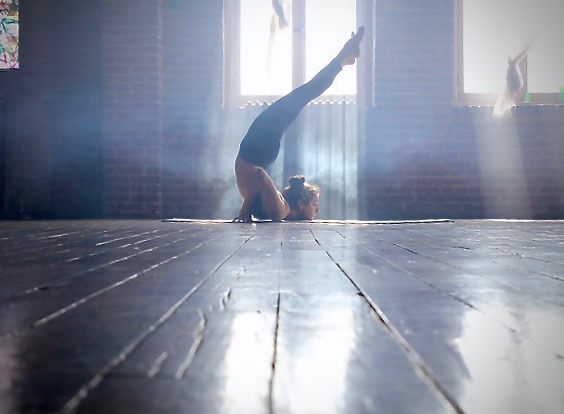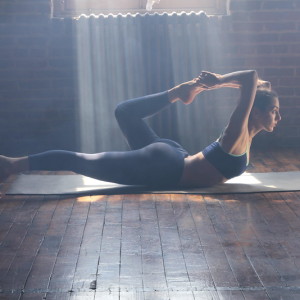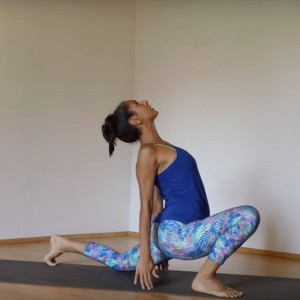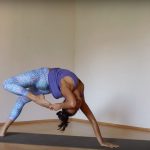Why Shoulder Stand Is Obsolete ~ Maya Devi Georg
I stopped practicing and teaching shoulder stand (Sarvangasana) years ago. It was around the time I got a cell phone, and that is no accident. There’s no reason for anyone to practice shoulder stand anymore because most people spend hours everyday in the same position.
Between cellular phones, laptops, and tablets most people already spend hours every day with chins tucked into chests. This extreme and almost constant flexion of the cervical spine puts pressure on our neck joints, collapses our chest and shoulders, and damages our posture. It also leads to cervical degeneration with pain felt in the neck, shoulder, back, arms, fingers, hands, wrists and elbows. It is associated with headaches and numbness/tingling of the upper extremities.
It is so common it has a name: Tech Neck.
It is as painful as it is widespread and if you have these symptoms see a medical doctor. In fact, if you have any medical concerns check with your doctor about practicing yoga. After being cleared by your doctor to practice, inform your yoga teacher of any health issues you may have to help prevent against creating or exacerbating any injuries.
Many students rush to classes around their work schedule, and usually to undo the physical ravages of a full-time desk job. So, I was incredibly surprised to see a student in a lunch-time yoga class suffering from neck and shoulder pain due to her work opt out of a basic back strengthening exercise to do a shoulder stand – and then skip the counter pose.
Almost every yoga pose has a counter pose. They basically stretch and strengthen the body in the opposite direction of the primary pose. They close joints that were just opened, stretch the muscles that were engaged, and engage the muscles that were stretched. They are the poses that bring our body back into balance.
In shoulder stand the chin is tucked into the chest and the joints in the neck are pushed open while the throat is closed off. This is pretty much the same position people read emails, send texts, and surf the internet. In shoulder stand this position is intensified as the neck and shoulders bears most of the body’s weight.
We are already in this position every day, sometimes for hours. We need to spend a lot more time stretching in the opposite direction.
The traditional counter pose for shoulder stand is fish pose (Matsyasana). Fish pose basically closes off the neck and opens the throat, balancing the strength and flexibility of the cervical spine.
To practice the fish pose begin by laying down on your back, lift and support the torso by resting on the forearms (fingers or hands are tucked under the upper part of the buttocks). With a inhalation allow the head to fall back, as the heart and chest lift up to the ceiling. The crown of the head should rest on the floor, although there should be no pressure on the head or neck – the back muscles should be engaged strongly, and the arms should support the weight of the body.
But fish pose isn’t the only option. The solution can be as easy as looking up.
With an inhalation sit up straight, shoulders back and heart lifting. With the next inhalation, lift the chin and look up. Keep the shoulders rolling back and the chest pressing forward. If you have a neck injury you can roll up a towel and place it around your neck so that you do not over stretch.
But any back bend will help, as long as the neck is relaxed and the head allowed to fall back. Lay in bed with pillows placed under the upper back and allow the head to fall back onto the mattress; or roll a balance ball or yoga wheel along the length of the spine keeping the head and neck relaxed; or even sitting upside down on a couch or chair with legs and feet up the wall (this grants the added benefit of being inverted) and let gravity pull the head towards the floor.
Or you can just take breaks from your electronics and look up.
And if you suffer from neck, shoulder, and upper back pain from staring at a screen all day, you might want to avoid practicing a yoga pose that is just a more extreme version of what caused that pain in the first place.
(C) Copyright 2018. All rights reserved.





